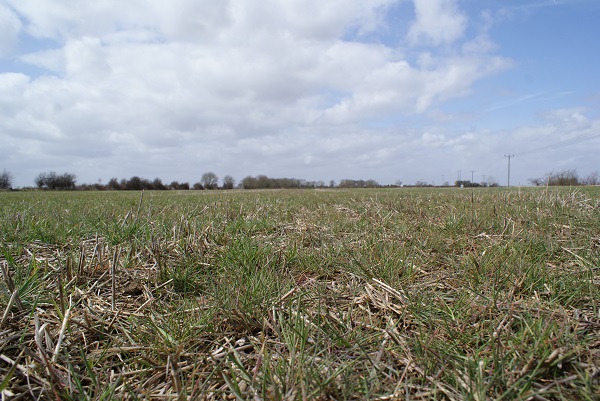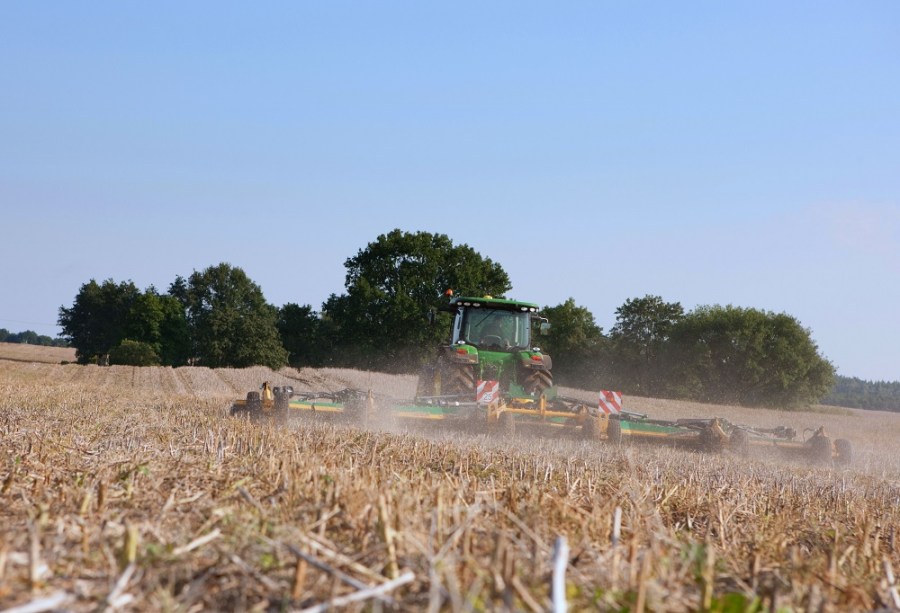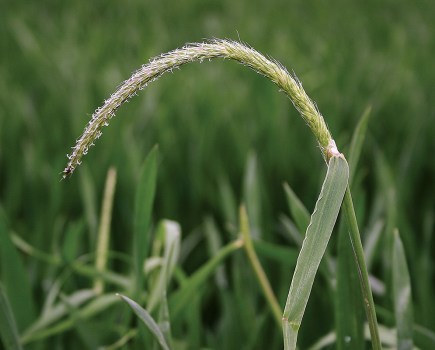Different problems require consideration when deciding how best to manage stubbles. CPM asks a weed scientist, entomologist and plant pathologist for their best practice advice to combat some of the most problematic weeds, pests and diseases.
We need to start asking the questions again that we’ve never really answered.
By Lucy de la Pasture
Stubbles provide a useful opportunity to reduce the impact of weeds, insect pests and diseases in the following crop. Inevitably best practice for one problem may be less desirable for another but knowing the wider consequences of taking a particular course of action is what really matters.
Weed scientist Dr Stephen Moss believes the best stubble management for long-term weed control is still unclear. “You can adopt post-harvest management strategies which either involve maximum disturbance, such as ploughing, or alternatively you can do nothing and leave stubbles untouched for weeks. And, of course, everything in between these two extremes,” he says.

Controlling blackgrass in minimal disturbance tillage systems is a balancing act and needs managing carefully with the help of appropriate rotations and drilling dates.
“The best option will vary between farms, but I still think there’s a lot to be learned about the best long-term strategy, not just for weed control, but also from a soil fertility, pest and disease control perspective.”
Where blackgrass, ryegrass, wild oats and volunteer oilseed rape are the main problem, there’s good research that shows leaving the stubbles untouched for 6-8 weeks or more after harvest is the best way of depleting the numbers of freshly shed seeds.
“But, in practice the need to incorporate straw residues is often seen as the priority, especially for autumn sown crops. Delaying autumn cultivations prior to growing spring crops is more realistic and I would like to see more research done to quantifying the benefits. Delayed autumn cultivations followed by spring-sown crops has the potential to be a ‘double whammy’ for blackgrass control,” believes Stephen.
It’s a different story where some brome species are the main grassweed but it’s important to know which species you’re dealing with before deciding to go in with a cultivator. There’s a clear division between the bromes when it comes to the best post-harvest strategy, with sterile brome and great grouped together.
“For these two species, light stops the seeds from germinating so a shallow cultivation, straight after harvest, will encourage a flush of the weed which can then be sprayed-off with glyphosate,” he comments.
But when it comes to the other three species – soft brome (Bromus hordaceous), meadow brome (Bromus commutatus) and rye brome (Bromus secalinus) – the opposite post-harvest management applies.
“For these three bromes cultivations encourage dormancy because the seeds are immature when they’re shed. It’s best to leave their seeds on the surface immediately after harvest so that they can ripen and delay any cultivations, ideally for a minimum of four weeks,” advises Stephen Moss.
In practice, many growers go in straight after the combine with a shallow cultivation “This will encourage many old seeds to germinate but for seeds from the current season’s blackgrass, ryegrass seeds and the group of three bromes, it will have the opposite effect and their seeds are more likely to be preserved by burial.,” he says.
All the research Stephen has been involved with indicates that min-till and no-till systems potentially encourage blackgrass which, if allowed to get the upper hand, may build up faster than in a conventional tillage system, he says.
“That’s not to say blackgrass can’t be managed well using reduced cultivations. It can, but it’s a balancing act and needs managing carefully with the help of appropriate rotations and drilling dates.”
With an increased reliance on residual herbicides in the programme it’s possible that reduced tillage systems may be helping them work better, believes Stephen.
“The blackgrass seeds will be kept in a superficial layer near to the soil surface so, in theory, should be more vulnerable to residual herbicides, though I have no data to prove it,” he adds.
If rotational ploughing is carried out well, with good inversion, more seeds will be turned down than brought up, helping to reduce the blackgrass population. “Good inversion is essential and ploughing in autumn before growing a spring crop may well be the best time to carry out rotational ploughing,” he says.
Stubble management also plays a crucial role where insect pests are concerned, particularly when it comes to removing the ‘green bridge’ which would otherwise put crops at risk from the insects and disease inoculum it harbours.
Although managing the green bridge is an agronomic principle that’s been established for more than thirty years, there has been no modern-day research into establishing the best techniques and timings, says ADAS entomologist, Dr Steve Ellis.
“The research that has been done indicates that the best way to reduce aphid transfer from the old to the newly planted crop is to destroy the green bridge with a desiccant 7-10 days pre-ploughing or cultivations.”
The aim is to eliminate the threat from aphids, so the newly emerging crop isn’t at risk from BYDV from the outset. The BYDV threat from migratory aphids could then be monitored and managed with insecticides, explains Steve.
He believes there’s now a need to conduct further applied research into the green bridge, particularly since the EU’s decision to ban the neonicotinoid clothianidin, used in Deter seed treatment to provide seedling protection against early BYDV infection.
“The obvious alternative is pyrethroid spray, but we’ve relied on these products for far too long and insecticide-resistant grain aphids have been recorded as well as resistance in a number of other insect pests.
“BYDV transmission from aphids surviving on the green bridge is less common than the threat from migratory aphids but potentially far more damaging. This is because crops could be infected in their very early growth stages.
“The problem with BYDV control has always been we don’t know whether aphids are actually carrying the virus, so the advice has been to apply an insecticide when they’re seen in the crop, so we have been applying chemicals where they’re not necessarily required.
“The only way forward to manage aphids and BYDV is an integrated pest management approach. That means we need to start asking the questions again that we’ve never really answered,” he says.
Answering the question on the infectivity of aphids is a crucial one and Steve believes the advances in in-field DNA testing will eventually enable this.
“Rothamsted used to monitor aphids and provide an infectivity index based on the number of aphids migrating into crops and the percentage of them that were carrying BYDV to provide some information on risk,” he adds.
The other pertinent question is when the green bridge should be destroyed and how long it must be left under different tillage systems before drilling the new crop. Much of the research into the relationship between the green bridge and aphid numbers was carried out using paraquat as a desiccant, reminds Steve.
“Paraquat was a herbicide that also had an insecticidal effect and the research shows that it was responsible for killing 80-90% of the aphids present in stubbles. Glyphosate doesn’t have this incidental effect on aphids.”
For that reason, Steve isn’t certain you can apply the traditional guidance of 7-10 days after burning off a stubble. “Presumably glyphosate needs to be left for longer, until all the green material has been destroyed,” he suggests. “Old ADAS advisory leaflets suggest that there should be a period of at least five weeks between ploughing and sowing the new crop.”
When it comes to oilseed rape stubbles, Steve is investigating using the volunteers as a trap crop for cabbage stem flea beetle (CSFB) as a way of reducing damage to the newly planted OSR crop.
“A scientific paper written in the 1950s suggests that once a CSFB migrate into a crop their wing muscles begin to deteriorate so they can’t then move on to another field. We began to investigate whether we could use OSR volunteers as a trap crop last autumn and initial results look encouraging,” he says.
“Two pairs of fields were compared, with one field post-OSR and the other due to be sown with OSR in the autumn. Over a period of four weeks we consistently found fewer CSFB in new crops planted adjacent to the field where the previous OSR crop’s stubbles was allowed to remain in comparison with crops planted adjacent to the field where the volunteers were removed early. We also recorded a smaller loss in green leaf area and the number of plants/m2 was higher,” he says.
Steve notes that there appears to be a relationship between the area of OSR stubble left and its effectiveness as a trap crop. “At one site the farmer was reluctant to leave all of his stubble so only left OSR volunteers in a proportion of the field, which we don’t believe was a large enough area to act as a trap crop,” he explains.
More work is being done this year to build on the first year’s data, as well as some laborious work with a scalpel to attempt to validate the theory that CSFB lose wing muscle when they migrate into crops.
When it comes to the effects of stubble management on managing disease inoculum, ADAS pathologist Dr Julie Smith also believes there’s scope to refine advice to growers through more research.
“Most people will be prioritising grassweed control when it comes to stubble management but there is also a useful opportunity to reduce the inoculum of some diseases,” she says.
“For diseases initiated by airborne ascospores from the previous years infected crop, such as septoria, phoma and light leaf spot (LLS), cultivation strategy is important. As these diseases carry-over on crop debris, chopping or removing the straw and burying the trash will help reduce potential inoculum. There is noticeably more disease in the new crop when it has been planted adjacent to fields containing infected stubble, or when it’s established using minimum tillage cultivations.
“For diseases such as yellow rust, BYDV, take-all and club root, destroying the volunteers and weeds that provide the green bridge will help reduce the inoculum that could result in an early epidemic in the newly planted crop,” she explains.
When it comes to timing cultivations or glyphosate applications then things become less certain as there hasn’t been any joined-up research on stubble management, says Julie. “For example, where crop residues are infected by phoma approximately 20 collective days of rain from harvest onwards is needed to trigger ascospore release, so the aim should be to bury crop debris within that timescale.
“If club root is a problem then any cruciferous weeds, regrowth or OSR volunteers need to be got rid of straight away. Research from Germany shows that resting spores can be present one week after the emergence of volunteers and that early destruction of these volunteers can significantly reduce symptoms later on,” she adds.
All three scientists agree that stubble management has been neglected when it comes to applied research and more work could be done to look at the effect on the whole farming system – including soil health and wildlife – to provide a better framework to make agronomic decisions.




